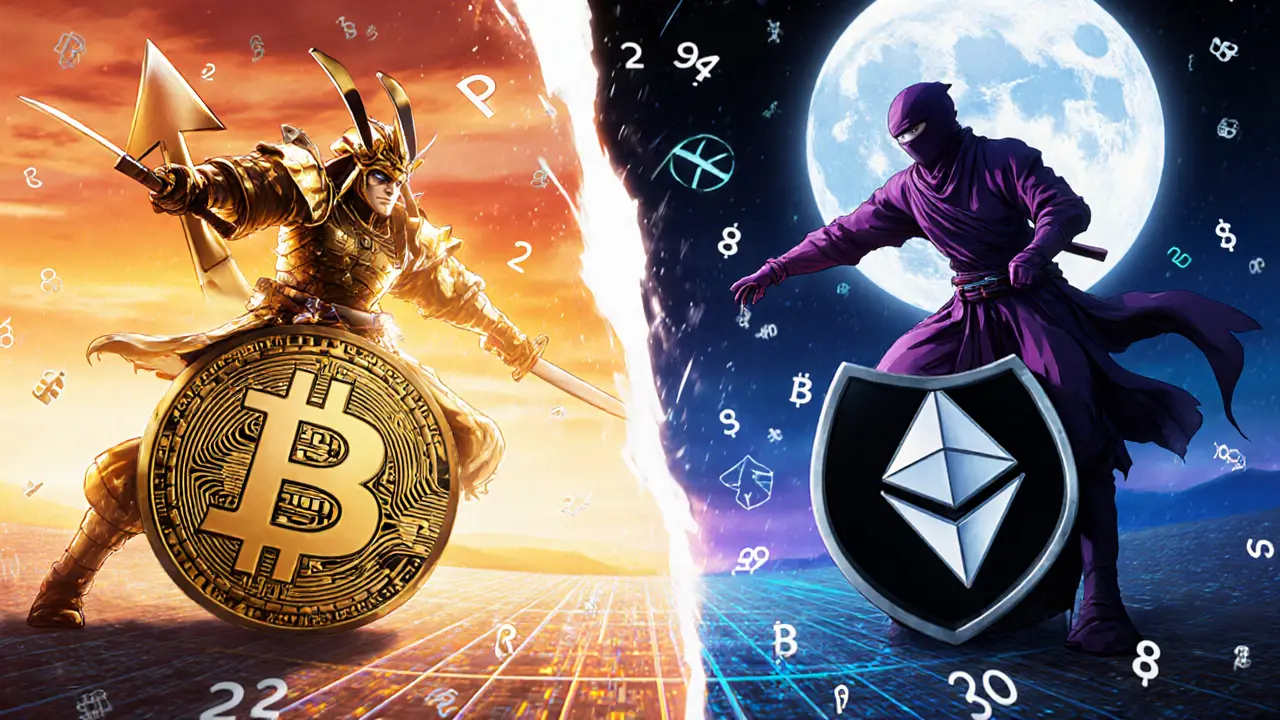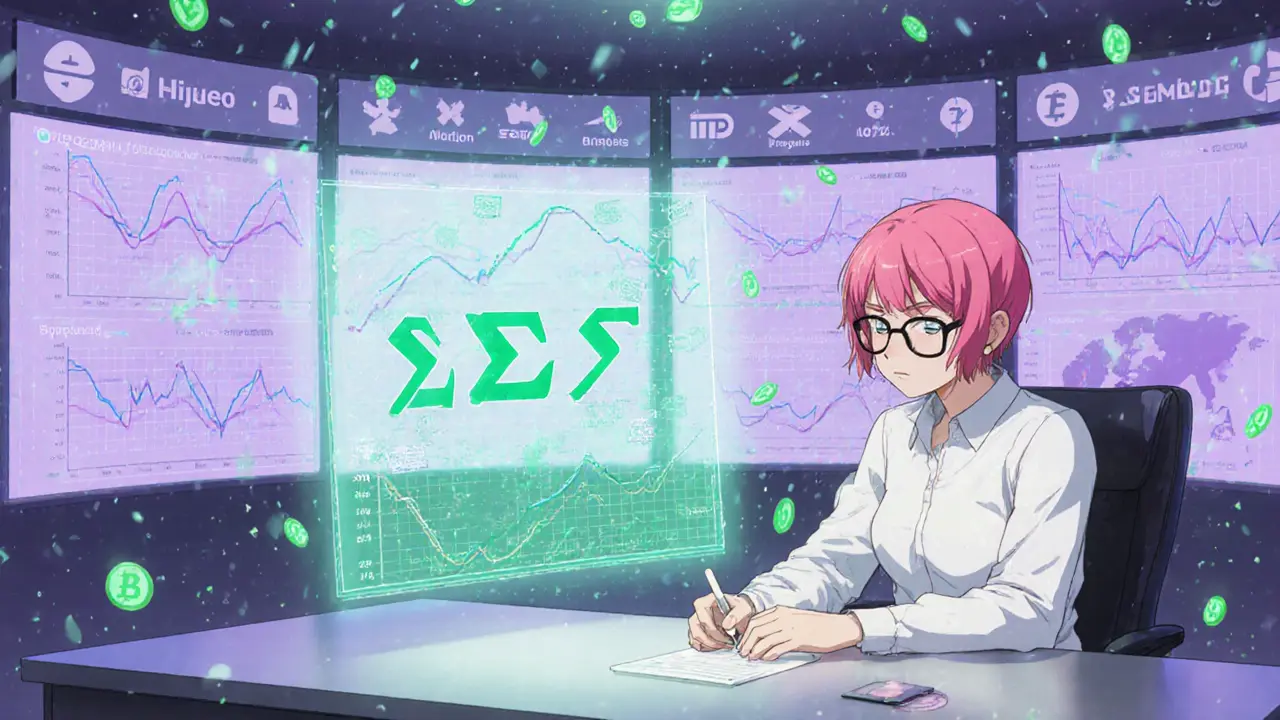Crypto Options Profit Calculator
If you’re curious about cryptocurrency options, you’ve landed in the right spot. These contracts let you bet on where a digital asset’s price will go without actually owning the coin. In 2025 the crypto derivatives arena is moving faster than ever, with more than $1trillion in annual volume. That means there’s a lot of money, a lot of risk, and a lot of opportunity for anyone willing to learn the basics and avoid common pitfalls.
Key Takeaways
- Crypto options give you the right, not the obligation, to buy or sell a cryptocurrency at a set strike price before expiration.
- Two main types - call options (bullish) and put options (bearish) - can be exercised American‑style or European‑style.
- Your maximum loss is the premium you pay, which makes options a limited‑risk way to gain leveraged exposure.
- Options can protect a spot position, generate income, or serve as pure speculation.
- Understanding Greeks, time decay, and implied volatility is essential before moving beyond simple directional bets.
What Are Cryptocurrency Options?
In plain language, a cryptocurrency option is a contract that grants the holder the right, but not the obligation, to buy or sell a digital asset at a predetermined price before a specific expiration date. The contract’s value comes from the underlying crypto - usually Bitcoin (BTC) or Ethereum (ETH) - so it’s classified as a derivative.
Unlike spot trading where you actually hold the coin, an option is a promise. The exchange holds the contract, you pay a premium up‑front, and the settlement can be in fiat or the crypto itself depending on the platform.
Core Components of a Crypto Option
Every option contract contains four building blocks:
- Premium - the price you pay for the right to exercise the contract.
- Strike Price - the preset price at which you may buy (call) or sell (put) the underlying asset.
- Expiration Date - the last day the contract is valid.
- Underlying Asset - the specific cryptocurrency (e.g., Bitcoin, Ethereum) the option references.
Premiums fluctuate with three main drivers: the current price of the underlying, the time remaining until expiration, and the asset’s volatility.
Calls vs. Puts: When to Use Each
A call option gives you the right to buy the underlying crypto at the strike price. You’d buy a call when you expect the price to rise.
A put option lets you sell the underlying at the strike price. You’d buy a put when you anticipate a price drop.
Both can be structured as American‑style (exercise anytime before expiry) or European‑style (exercise only on expiry). American‑style offers more flexibility, while European‑style is generally cheaper because of lower optionality.
| Feature | Call Option | Put Option |
|---|---|---|
| Right | Buy underlying | Sell underlying |
| Typical Outlook | Bullish | Bearish |
| Profit When | Underlying > Strike + Premium | Underlying < Strike - Premium |
| Maximum Loss | Premium paid | Premium paid |
| Common Use | Speculation, upside leverage | Hedging, downside protection |
Simple Example: A Bitcoin Call
Imagine Bitcoin is trading at $50,000 and you think it will climb to $55,000 within a month. You buy a call with a $52,000 strike, a one‑month expiry, and a $1,000 premium.
Break‑even point = Strike + Premium = $53,000. If Bitcoin ends at $55,000, you can exercise the option, buy at $52,000, and immediately sell at $55,000, netting $2,000 profit after the premium. If Bitcoin stalls below $52,000, the option expires worthless and you lose only the $1,000 premium.
This illustrates the core advantage: your downside is limited to the premium, while upside can be many times larger.

Risk Profile & Why Options Can Be Safer Than Spot
When you own Bitcoin outright, a 30% drop means a 30% loss on your investment. With a call option, the same move only wipes out the premium you paid. That limited‑risk exposure is why many traders view options as a “insurance policy” for crypto portfolios.
However, it’s not risk‑free. Premiums can be expensive in high‑volatility periods, and if you consistently buy out‑of‑the‑money options, the losses can accumulate.
Key risk concepts to keep in mind:
- Time Decay (Theta) - the option’s value erodes as expiration approaches.
- Implied Volatility (IV) - higher IV inflates premiums; a drop in IV can shrink option price even if the underlying stays flat.
- Assignment Risk - for American‑style options, you might be forced to deliver or accept the underlying before expiry.
Strategic Uses: Hedging, Income, and Speculation
1. Hedging a Spot Position - Suppose you hold 2BTC at $48,000 each. Buying a $45,000 put protects you from a dip below that level. If price falls to $40,000, the put gains value, offsetting the loss on the spot holdings.
2. Generating Income with Covered Calls - Own 1ETH at $3,200 and sell a $3,500 call for a $150 premium. If ETH stays below $3,500, you keep the premium as extra income. If it spikes above, you still profit from the premium plus the $300 capital gain.
3. Pure Speculation - Use short‑dated, out‑of‑the‑money calls on a meme‑coin you expect to surge after a major listing. The cost is low, but be prepared to lose the premium if the rally never materializes.
These examples show how a single instrument can serve multiple purposes, often within the same portfolio.
Choosing a Platform: What to Look For
Not all exchanges are equal. When picking a venue, examine:
- Settlement Method - Does the platform settle in fiat, stablecoins, or the native crypto? Choose what matches your cash‑flow needs.
- Contract Types - Availability of American vs. European style, range of strikes, and expiries (weekly, monthly, quarterly).
- Liquidity - Tight bid‑ask spreads reduce slippage, especially for larger orders.
- Regulatory Status - A licensed exchange can provide better consumer protections and clearer tax reporting.
- Security - Look for cold‑storage custody of the underlying, multi‑sig withdrawals, and insurance coverage.
Popular choices in 2025 include Binance Futures, Deribit, and the newer decentralized protocol Opyn, each with its own trade‑off between user experience and decentralization.
Learning the Greeks: Your Decision‑Making Toolbox
The “Greeks” quantify how an option’s price reacts to market changes:
- Delta - Sensitivity to underlying price moves. A call with a delta of 0.6 means a $1 rise in Bitcoin adds roughly $0.60 to the option’s price.
- Gamma - Speed of delta change. High gamma near expiry means delta can swing wildly.
- Theta - Time decay per day. A theta of -$5 means you lose $5 in value each day if everything else stays static.
- Vega - Sensitivity to implied volatility. Rising IV boosts option price, falling IV hurts it.
- Rho - Sensitivity to interest rates - less relevant in crypto but still part of a full model.
Understanding these helps you pick the right strike and expiry, and decide whether to roll a position before time decay eats away profits.
Common Pitfalls and How to Avoid Them
1. Overpaying Premiums - In high‑vol markets, premiums can be inflated. Use a volatility‑adjusted calculator to check if the price makes sense.
2. Ignoring Liquidity - Thin order books can cause you to pay a wide spread, eroding any potential profit.
3. Holding Out‑of‑the‑Money Options Too Long - The longer you wait, the more theta drains value. Consider scaling out or rolling forward.
4. Not Accounting for Tax Implications - Many jurisdictions treat options as capital assets with distinct rules. Keep detailed records of premiums, expirations, and settlements.
5. Forgetting Assignment Risk - With American‑style calls, you could be assigned early, forcing you to buy the underlying at a higher price. Use cash‑settled contracts if you want to avoid physical delivery.
Next Steps: Building Your First Crypto Options Play
- Open a demo account on a reputable exchange and explore the options dashboard.
- Pick a simple strategy - a single‑leg call or put on Bitcoin or Ethereum.
- Calculate the break‑even point using the premium and strike price.
- Set a stop‑loss on the premium amount you’re willing to lose.
- Monitor Greeks daily; if theta is eating away too fast, consider closing or rolling the position.
Once comfortable, you can experiment with multi‑leg spreads, covered calls, or protective puts to fine‑tune risk‑return.

Frequently Asked Questions
What is the main difference between a crypto option and a crypto future?
An option gives you the right but not the obligation to trade at a set price, while a future obligates you to buy or sell at expiration. Options limit loss to the premium; futures can require margin calls and unlimited loss.
Can I settle a crypto option in fiat?
Yes, many centralized exchanges settle in USD, USDT, or other stablecoins. Decentralized platforms often settle in the underlying crypto.
How does implied volatility affect option pricing?
Higher implied volatility inflates premiums because the market expects larger price swings. If volatility drops after you buy, the option’s price can fall even if the underlying stays flat.
Is it better to trade American or European style options?
American style offers flexibility to exercise early, which can be useful for dividend‑like events or sudden news. European style is typically cheaper and works well for pure directional bets where early exercise isn’t needed.
Do crypto options expire on weekends?
Most exchanges follow a Monday‑to‑Friday schedule, but some platforms list weekend expiries for popular assets. Check the contract specifications before trading.







Comments
VICKIE MALBRUE
April 5, 2025 AT 12:43 PMGreat stuff keep exploring crypto options
april harper
April 5, 2025 AT 18:16 PMIn the grand theater of finance, crypto options are the shadow actors that whisper possibilities to the daring.
One can feel the weight of potential profit and loss like storm clouds gathering on a distant horizon.
The drama unfolds as you balance the premium against the fickle nature of digital assets.
Yet, amid the chaos, a quiet confidence can arise from disciplined study.
Remember, the most profound insights often emerge from the stillness between the market's roar.
Kate Roberge
April 5, 2025 AT 23:50 PMEveryone's buzzing about "limitless upside" but they forget the premiums can drain your wallet faster than a meme coin spike.
If you think a put is just insurance, you’re missing the fact that it can also lock you into a losing position when volatility collapses.
MD Razu
April 6, 2025 AT 05:23 AMDiving into crypto options is like stepping onto a tightrope above a canyon of volatility.
You must first understand that every premium you pay is a silent contract with the market's future self.
The Greeks are not mere academic terms; they are the compass and the wind that steer your ship.
Delta tells you how much the option will move when the underlying wiggles, a whisper of direction.
Gamma, on the other hand, is the sudden gust that can flip your course in an instant.
Theta erodes your position like sand through hourglass, reminding you that time is an adversary.
Vega breathes life into the option when volatility surges, but it also kills it when calm returns.
Rho, though often ignored in crypto, can still shift values when macro interest narratives change.
Choosing American versus European style is a decision of flexibility versus cost, each with hidden trade‑offs.
Liquidity, the often underrated beast, determines whether you can enter or exit without paying a king's ransom.
When you hedge a spot position with a put, you are essentially buying insurance against your own optimism.
Conversely, selling a covered call is like renting out your asset for a modest fee while ceding upside.
In 2025, the proliferation of decentralized protocols adds another layer of counter‑party risk you must weigh.
Never forget to calculate the break‑even point; it is the baseline from which profit or loss is measured.
If you ignore the interplay of these variables, you are courting loss with a smile.
Therefore, before you press the execute button, sketch the entire risk‑reward diagram in your mind.
Charles Banks Jr.
April 6, 2025 AT 10:56 AMSure, because nothing says "smart trader" like ignoring theta until it eats your premium.
Enjoy the ride.
Ben Dwyer
April 6, 2025 AT 16:30 PMStart small and treat each trade as a learning experiment.
Track your premiums and adjust strikes as you get comfortable.
Consistent practice will build the confidence you need.
Michael Wilkinson
April 6, 2025 AT 22:03 PMStop treating options like a lottery ticket and start applying real risk management.
Enough with the reckless bets.
Billy Krzemien
April 7, 2025 AT 03:36 AMWhen selecting a platform, prioritize strong security measures, such as multi‑signature custody and cold storage.
Liquidity depth is crucial to avoid slippage, especially on larger positions.
Finally, ensure the settlement method aligns with your cash‑flow preferences.
Clint Barnett
April 7, 2025 AT 09:10 AMImagine the crypto options market as a bustling bazaar where every stall offers a different flavor of risk.
One can wander from a quiet hedging booth to a flamboyant speculative tent, each adorned with glittering Greeks and volatile banners.
The aromas of premium payments mingle with the sharp scent of potential profit, creating an intoxicating perfume for the daring trader.
Yet, just as a seasoned traveler packs a compass, you must equip yourself with knowledge of delta, theta, and vega before you set foot inside.
Remember, the most colorful stories emerge from those who respect both the market’s beauty and its brutal edges.
Choose your strikes wisely, and let the market’s rhythm guide your steps.
Jacob Anderson
April 7, 2025 AT 14:43 PMNice overview, but the real world fees will eat most of that "profit" you talk about.
Don’t forget the exchange spread.
Kate Nicholls
April 7, 2025 AT 20:16 PMThe guide covers the basics well, yet it glosses over the tax implications that can surprise many newcomers.
A clear breakdown would make it complete.
Rajini N
April 8, 2025 AT 01:50 AMOne practical tip: always check the implied volatility rank before opening a position; high IV can inflate premiums.
If the rank is low, you might be overpaying for limited upside.
Also, consider using cash‑settled contracts if you want to avoid actual delivery of the crypto.
Finally, keep a spreadsheet of your trades to track P&L and adjust strategies over time.
Amie Wilensky
April 8, 2025 AT 07:23 AMIndeed, the mechanics are, quite frankly, fascinating; however, one must, without hesitation, scrutinize the underlying asset's correlation, volatility, and liquidity-otherwise, the entire strategy could, arguably, become a speculative folly.
Lindsay Miller
April 8, 2025 AT 12:56 PMIt can feel overwhelming at first, but taking it step by step really helps.
Start with a simple call or put and learn how the price moves.
Katrinka Scribner
April 8, 2025 AT 18:30 PMOMG this is sooo cool 😍 i tried a call on BTC yesterday and omg the profit!
but tbh the premium was high 🙄
Waynne Kilian
April 9, 2025 AT 00:03 AMI think we all need to calm down and look at the data, not the hype.
There’s value in both sides, lets try to understand each other.
Naomi Snelling
April 9, 2025 AT 05:36 AMEver wonder why the big exchanges push options that seem too good to be true?
Maybe there’s a hidden agenda to keep retail traders locked in.
Carl Robertson
April 9, 2025 AT 11:10 AMThe drama of options is intoxicating, yet the analytics often reveal a sobering reality.
Don’t get swept away by hype.
Oreoluwa Towoju
April 9, 2025 AT 16:43 PMStart with a single strike, watch the Greeks, and adjust as needed.
Jason Brittin
April 9, 2025 AT 22:16 PMNice guide, but remember that in real life, options can be a wild ride – strap in! 😎🚀